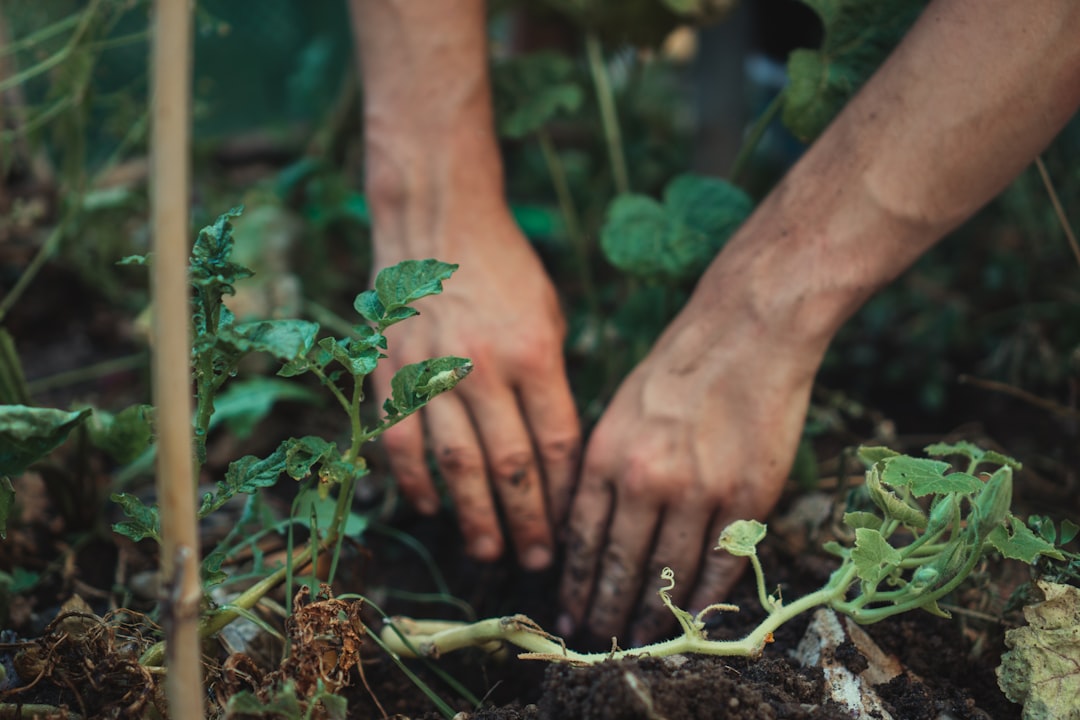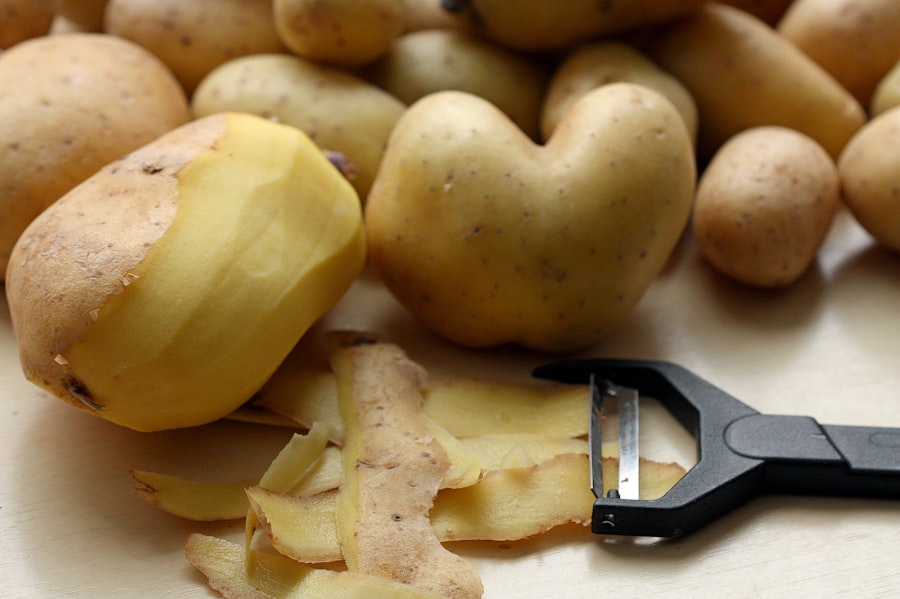Growing Potatoes Made Easy: Planting from a Potato

Growing potatoes from a potato is a simple and rewarding process that allows you to enjoy the satisfaction of growing your own food. Instead of buying seed potatoes, which are specially grown for planting, you can use a regular potato from your kitchen to start your potato crop. This method is especially useful if you have leftover potatoes that have started to sprout. By planting these sprouted potatoes, you can give them a new lease on life and enjoy a bountiful harvest.
There are several benefits to growing potatoes from a potato. Firstly, it is a cost-effective way to start your potato crop. Instead of purchasing seed potatoes, which can be quite expensive, you can use the potatoes you already have at home. This not only saves you money but also reduces waste. Additionally, growing potatoes from a potato allows you to have more control over the quality of your crop. You can choose organic potatoes or those that are free from pesticides and chemicals. This ensures that you are growing healthy and nutritious potatoes for yourself and your family.
Choosing the Right Potato for Planting
When choosing a potato for planting, it is important to select the right type of potato. Not all potatoes are suitable for planting, as some varieties are better suited for cooking rather than growing. The best types of potatoes for planting are those that are known as “seed potatoes.” These are specifically grown for planting and have been certified disease-free.
There are several factors to consider when choosing a potato for planting. Firstly, look for potatoes that have started to sprout or have “eyes.” These sprouts indicate that the potato is ready to grow. Additionally, choose potatoes that are firm and free from any signs of rot or disease. It is also important to select potatoes that are the right size for planting. Smaller potatoes are ideal as they will produce multiple plants from one potato.
Preparing the Soil for Planting
Potatoes require well-draining soil that is rich in organic matter. Before planting, it is important to prepare the soil to create the optimal growing conditions for your potato plants. Start by clearing the area of any weeds or debris. This will prevent competition for nutrients and space.
Next, loosen the soil using a garden fork or tiller. This will help improve drainage and allow the potato roots to penetrate the soil easily. If your soil is heavy or clay-like, consider adding organic matter such as compost or well-rotted manure to improve its texture and fertility.
Cutting and Preparing Seed Potatoes
| Task | Time Required | Tools Required | Success Rate |
|---|---|---|---|
| Cutting Seed Potatoes | 30 minutes | Sharp Knife, Cutting Board | 90% |
| Preparing Seed Potatoes | 15 minutes | Bucket, Water, Towel | 95% |
| Storing Seed Potatoes | 10 minutes | Mesh Bags, Cool, Dark Place | 100% |
Using seed potatoes is important for successful potato growth. Seed potatoes are specially grown for planting and are certified disease-free. They provide a reliable source of healthy and vigorous potato plants.
To prepare seed potatoes for planting, start by cutting them into smaller pieces. Each piece should have at least one sprout or “eye.” It is important to cut the potatoes a few days before planting to allow the cut surfaces to dry and form a protective layer. This helps prevent rotting and disease.
Planting and Spacing Potatoes
The best time to plant potatoes is in early spring, once the soil has warmed up and there is no longer a risk of frost. To plant potatoes, dig a trench that is about 4-6 inches deep. Place the seed potatoes in the trench, with the sprouts facing up. Space the potatoes about 12-15 inches apart, with rows spaced about 2-3 feet apart.
Cover the seed potatoes with soil, leaving a small mound on top. As the plants grow, you can gradually add more soil around the base of the plants to encourage more tuber development.
Watering and Fertilizing Potatoes

Potatoes require consistent moisture throughout their growing season. It is important to water them regularly, especially during dry periods. However, be careful not to overwater as this can lead to rotting and disease.
In terms of fertilization, potatoes benefit from a balanced fertilizer that is high in potassium. This helps promote tuber development. You can apply a slow-release fertilizer at planting time and then side-dress the plants with additional fertilizer once they start to grow.
Controlling Weeds and Pests in Potato Plants
Weeds can compete with potato plants for nutrients and space, so it is important to control them. Regularly hoeing or hand-pulling weeds can help keep them in check. Additionally, applying a layer of mulch around the base of the plants can help suppress weed growth.
Potato plants are susceptible to several pests, including aphids, Colorado potato beetles, and wireworms. To control these pests, you can use organic methods such as handpicking or spraying with insecticidal soap. It is important to monitor your plants regularly and take action at the first sign of pest infestation.
Harvesting and Storing Potatoes
Potatoes are ready for harvesting when the foliage starts to die back and turn yellow. This usually occurs about 2-3 months after planting. To harvest potatoes, gently dig them up using a garden fork or shovel. Be careful not to damage the tubers during the process.
After harvesting, it is important to cure the potatoes before storing them. Cure the potatoes by placing them in a cool, dark, and well-ventilated area for about 2 weeks. This allows the skins to toughen up and any minor cuts or bruises to heal.
Once cured, store the potatoes in a cool and dark place such as a root cellar or basement. Avoid storing them near fruits or vegetables that produce ethylene gas, as this can cause the potatoes to sprout prematurely.
Tips for a Successful Potato Crop
To ensure a successful potato crop, here are some tips to keep in mind:
1. Choose the right variety: Different potato varieties have different growth habits and flavors. Choose a variety that suits your preferences and growing conditions.
2. Rotate your crops: Avoid planting potatoes in the same spot year after year to prevent the buildup of pests and diseases in the soil.
3. Hill the plants: As the potato plants grow, gradually add more soil around the base of the plants to encourage more tuber development.
4. Monitor for pests and diseases: Regularly inspect your plants for signs of pests or diseases and take action at the first sign of trouble.
5. Practice good sanitation: Clean up any plant debris or fallen potatoes to prevent the spread of diseases.
Common Mistakes to Avoid When Growing Potatoes from a Potato
While growing potatoes from a potato is a relatively simple process, there are some common mistakes that can hinder your success. Here are some mistakes to avoid:
1. Using potatoes that are not suitable for planting: Not all potatoes are suitable for planting. Make sure you choose seed potatoes that are certified disease-free and have started to sprout.
2. Planting too early or too late: Potatoes should be planted in early spring, once the soil has warmed up and there is no longer a risk of frost. Planting too early can result in frost damage, while planting too late can result in poor tuber development.
3. Overwatering or underwatering: Potatoes require consistent moisture throughout their growing season. Be careful not to overwater or underwater, as this can lead to rotting or stunted growth.
4. Neglecting weed control: Weeds can compete with potato plants for nutrients and space. Regularly hoeing or hand-pulling weeds can help keep them in check.
5. Failing to monitor for pests and diseases: Regularly inspect your plants for signs of pests or diseases and take action at the first sign of trouble.
In conclusion, growing potatoes from a potato is a simple and rewarding process that allows you to enjoy the satisfaction of growing your own food. By choosing the right potato, preparing the soil, cutting and preparing seed potatoes, planting and spacing potatoes, watering and fertilizing, controlling weeds and pests, harvesting and storing potatoes, and following some tips for success while avoiding common mistakes, you can have a successful potato crop right in your own backyard. So why not give it a try and enjoy the delicious taste of homegrown potatoes?



